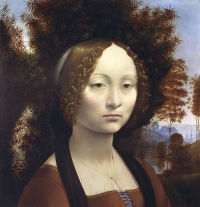Light and Vision Click on the thumbnails to explore the trail
Read more about this trail (expand)
According to Leonardo, the most important of the five senses was sight, the eye being the “window of the soul”. Leonardo thought a great deal about how the eye functioned and how we experience the world in terms of light and shade. His studies of the effects of light on form provided the basis for a revolution in the way that light, colour and space were described in painting.

- Enlarge
- Zoom & explore
- © National Gallery of Art, Washington
Portrait of Ginevra de' Benci 1476-78
Leonardo applied his understanding of the dynamic action of light to breathe life into his paintings.
Observing trees, he noticed how the surfaces of shiny leaves show less of their true colour and take on the lustre of reflected sunlight. Lustre he tells us, is not a colour but a “sensation of whiteness derived from the surface of wet bodies”. Light partakes of the colour of the object that reflects it to the eye as gold or silver highlights.
In this portrait, lustre is conveyed by means of oil paint. The fine, yellow-gold highlights of the figure’s hair convey its silky texture and reflective quality. These highlights not only add to the figure’s beauty, but also describe the shape of the head. Light dances on the curls that frame Ginevra’s face, conveying their inherent energy and the vitality of her painted form.
The lustrous quality of Ginevra’s hair also plays an important role in the harmonics of the painting. It sparkles against the dark leaves of the juniper tree behind just as the gold braid of the neckline of her dress enlivens the plain wool fabric of the gown.
In Leonardo's words
What is the difference between light and lustre which is seen on the polished surface of opaque bodies? The lights which are produced from the polished surfaces of opaque bodies will be stationary on stationary objects even if the eye on which they strike moves. But reflected lights will, on those same objects, appear as in many different places on the surface as different positions as taken by the eye.
Leonardo painted this portrait of Ginevra de’ Benci while still working in the workshop of Verrocchio in Florence.
The sitter has been identified from historical sources and by the Juniper bush (ginepro in Italian) seen behind her, which is thought to be a pun on her name. The Juniper is also a symbol of female virtue and this theme is continued on the reverse of the panel, where on a background of imitation red porphyry marble, Juniper, laurel and palm leaves are interwoven by a garland with the words VIRTUTEM FORMA DECORAT: “Beauty adorns Virtue”.
The front and back of the panels are closely linked as Ginevra’s beauty is to be understood as an expression of her virtue. The panel may have been cut at some point along the lower edge, where Ginevra’s hands may once have been. A drawing of hands now in the Royal Collection, Windsor, is thought to be related to this painting, and may give some idea of the original design.
- Medium Oil on panel with addition at bottom edge
- Size 42.7 x 37 cm
- Location National Gallery, Washington











